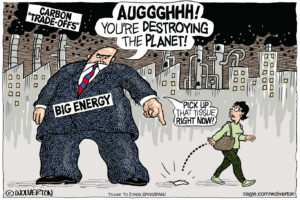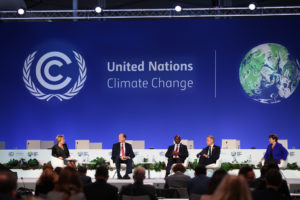Will Trump’s Climate Team Accept Any ‘Social Cost of Carbon’?
The nation’s top science panel has sketched a way to set a fair price for cutting climate risks. Some of the president-elect’s advisers say the price should be zero. Rubí Flórez / CC BY-NC-ND 2.0
Rubí Flórez / CC BY-NC-ND 2.0
By Andrew Revkin / ProPublica
President-elect Donald Trump and members of his proposed cabinet and transition team have taken aim at many of President Obama’s climate and clean-energy policies, programs and legacies — from the Paris Agreement to the Clean Power Plan.
But there’s probably no more consequential and contentious a target for the incoming administration than an arcane metric called the “social cost of carbon.”
This value is the government’s best estimate of how much society gains over the long haul by cutting each ton of the heat-trapping carbon-dioxide emissions scientists have linked to global warming.
Currently set at $36 per ton of carbon dioxide, the metric is produced using a complex, and contentious, set of models estimating a host of future costs to society related to rising temperatures and seas, then using a longstanding economic tool, a discount rate, to gauge how much it is worth today to limit those harms generations hence. (For context, the United States emitted about 5.1 billion tons of CO2 in 2015, out of a global total of 36 billion.)
The contention arises because the social cost of carbon underpins justifications for policies dealing with everything from power plants to car mileage to refrigerator efficiency. The carbon valuation has already helped shape 79 regulations.
The strongest sign of a coming challenge to the social cost calculation came in a post-election memorandum from Thomas Pyle, who was then president of the industry-funded American Energy Alliance and Institute for Energy Research and who now leads the Trump transition team for the Department of Energy. In the memo, he predicted policies resulting in “ending the use of the social cost of carbon in federal rule makings.”
Outright elimination of such a calculation is highly unlikely, according to interviews with a range of experts. The practice of estimating the economic costs and benefits of most government regulations began under an executive order of President Ronald Reagan in 1981. It has continued ever since. Climate-related regulations are no different. Several court rulings have affirmed the process.
But the Trump administration’s aim of lowering the operative “number,” possibly by a lot, is almost assured. In 2013, an economist from Pyle’s energy institute testified in a Senate hearing that under a proper calculation, the social cost of carbon “would probably be close to zero, or possibly even negative.”
A deep cut would be both dangerous and unjustified, given the basics of both climate science and economics, said Gernot Wagner, a Harvard economist focused on climate risk and policy. In a phone interview on Tuesday, he said the interagency working group assembled by the White House in 2009 to create the social cost measurement was “a damn impressive exercise at assembling a lot of firepower and done in a way that was about as apolitical as things can go in Washington.”
The result, he said, is, if anything, far too conservative. “What worries me most, frankly, is that the current social cost is basically being portrayed as the upper limit,” he said.
In fact, he and several other climate-focused economists said in interviews that the science, including persistent uncertainty on how fast temperatures and seas will rise, should result in a higher carbon cost and even more aggressive steps at limiting warming.
At the same time, he and other analysts agreed that there are issues with the way calculations have been done so far, reflected in a flood of comments received by the Office of Management and Budget in 2015.
A fresh independent assessment of ways to improve the process was just conducted by the National Academy of Sciences, the nation’s leading independent scientific advisory body.
The report, “Valuing Climate Damages: Updating Estimation of the Social Cost of Carbon Dioxide,” was released yesterday.
The main recommendation is to “unbundle” the mix of models behind that seemingly simple dollar figure. The models, melding climate science, demographic change and economics, project harms by looking at possible shifts in human populations, technologies, economies and the climate in coming decades.
The assumptions and uncertainties for each step could then be more clearly laid out in transparent ways that might constrain misinterpretations and boost societal, and political, acceptance.
Myles R. Allen, an author of the report and a climate scientist at Oxford University, said in an interview that such a structure could help clarify where data ends and societal and political choices begin.
“There are obviously political decisions which need to be made in any calculation like the social cost of carbon,” he said. “On the other hand, the way the climate system responds to greenhouse gas emission levels is not really up for political discussion.”
Here are some additional resources on the social cost of carbon and related issues:
-
The most readable, even enjoyable, summary of discount rates in the context of climate change was written by David Roberts, now at Vox, back in his Grist days: “Discount rates: A boring thing you should know about (with otters!).”
-
The two architects of the social cost of carbon, Michael Greenstone, who was on the White House Council of Economic Advisers early in Obama’s first term, and Cass R. Sunstein, at the Office of Management and Budget, wrote a Times op-ed in December in defense of the measurement headlined “Donald Trump Should Know: This Is What Climate Change Costs Us.”
-
Gernot Wagner co-authored a new working paper that offers lessons from risk-management practices used in investing in cutting through debates about the present value of limiting future climate risk: “Applying Asset Pricing Theory to Calibrate the Price of Climate Risk,” by Kent D. Daniel, Robert B. Litterman, and Gernot Wagner (National Bureau of Economic Research).
-
Richard J. Lazarus, a Harvard law professor, wrote a paper with perhaps the most succinct and apt title in academic literature: “Super Wicked Problems and Climate Change: Restraining the Present to Liberate the Future” (first published in the Cornell Law Review, July 2009).
-
I wrote a Dot Earth column on a climatologist’s view of the challenge in investing now for the far future called “How the Climate Challenge Could Derail a Brilliant Human Destiny.”
ProPublica is a Pulitzer Prize-winning investigative newsroom.
Your support matters…Independent journalism is under threat and overshadowed by heavily funded mainstream media.
You can help level the playing field. Become a member.
Your tax-deductible contribution keeps us digging beneath the headlines to give you thought-provoking, investigative reporting and analysis that unearths what's really happening- without compromise.
Give today to support our courageous, independent journalists.






You need to be a supporter to comment.
There are currently no responses to this article.
Be the first to respond.